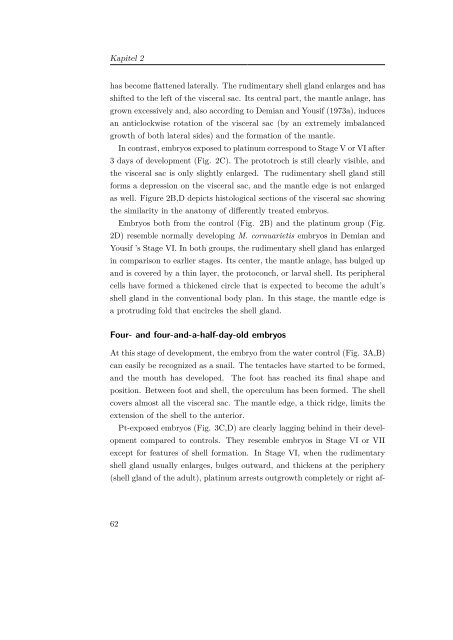Die Embryonalentwicklung der Paradiesschnecke ... - TOBIAS-lib
Die Embryonalentwicklung der Paradiesschnecke ... - TOBIAS-lib
Die Embryonalentwicklung der Paradiesschnecke ... - TOBIAS-lib
You also want an ePaper? Increase the reach of your titles
YUMPU automatically turns print PDFs into web optimized ePapers that Google loves.
Kapitel 2<br />
has become flattened laterally. The rudimentary shell gland enlarges and has<br />
shifted to the left of the visceral sac. Its central part, the mantle anlage, has<br />
grown excessively and, also according to Demian and Yousif (1973a), induces<br />
an anticlockwise rotation of the visceral sac (by an extremely imbalanced<br />
growth of both lateral sides) and the formation of the mantle.<br />
In contrast, embryos exposed to platinum correspond to Stage V or VI after<br />
3 days of development (Fig. 2C). The prototroch is still clearly visible, and<br />
the visceral sac is only slightly enlarged. The rudimentary shell gland still<br />
forms a depression on the visceral sac, and the mantle edge is not enlarged<br />
as well. Figure 2B,D depicts histological sections of the visceral sac showing<br />
the similarity in the anatomy of differently treated embryos.<br />
Embryos both from the control (Fig. 2B) and the platinum group (Fig.<br />
2D) resemble normally developing M. cornuarietis embryos in Demian and<br />
Yousif ’s Stage VI. In both groups, the rudimentary shell gland has enlarged<br />
in comparison to earlier stages. Its center, the mantle anlage, has bulged up<br />
and is covered by a thin layer, the protoconch, or larval shell. Its peripheral<br />
cells have formed a thickened circle that is expected to become the adult’s<br />
shell gland in the conventional body plan. In this stage, the mantle edge is<br />
a protruding fold that encircles the shell gland.<br />
Four- and four-and-a-half-day-old embryos<br />
At this stage of development, the embryo from the water control (Fig. 3A,B)<br />
can easily be recognized as a snail. The tentacles have started to be formed,<br />
and the mouth has developed. The foot has reached its final shape and<br />
position. Between foot and shell, the operculum has been formed. The shell<br />
covers almost all the visceral sac. The mantle edge, a thick ridge, limits the<br />
extension of the shell to the anterior.<br />
Pt-exposed embryos (Fig. 3C,D) are clearly lagging behind in their development<br />
compared to controls. They resemble embryos in Stage VI or VII<br />
except for features of shell formation. In Stage VI, when the rudimentary<br />
shell gland usually enlarges, bulges outward, and thickens at the periphery<br />
(shell gland of the adult), platinum arrests outgrowth completely or right af-<br />
62
















